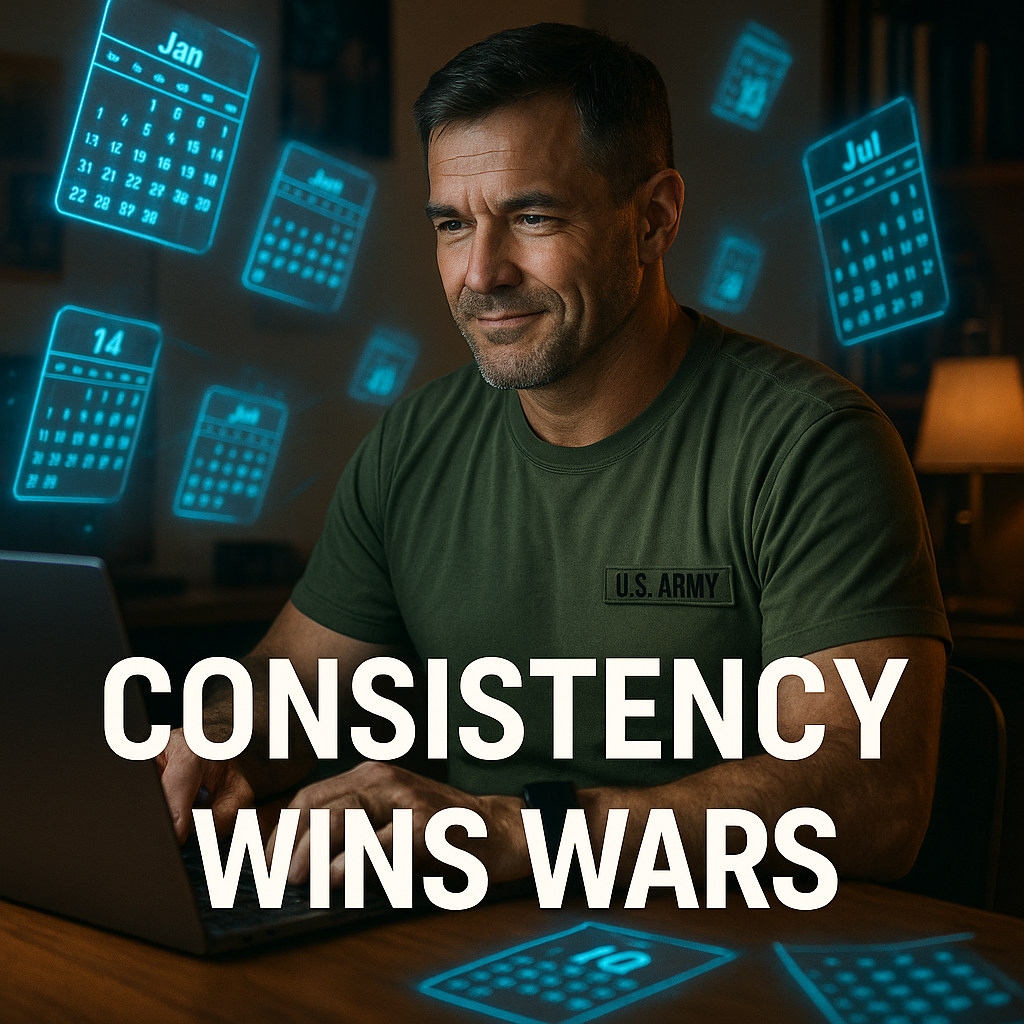Back when I was sitting in a noisy airport, I bumped into a former Navy strategist who, over a quick cup of (terribly overpriced) coffee, casually mentioned he was founding an AI-driven logistics company. That brief encounter stuck with me—the precision that guided him in the military was now being repurposed into cutting-edge business solutions. There’s something fascinating about how veterans harness skills honed under high-stakes pressure and translate them into the fast-evolving landscape of AI-powered business. Let’s unravel these connections and see just how far this blend of discipline and tech can take us.
From Battlefield to Boardroom: Where Discipline Meets Disruption
I've always been fascinated by career pivots. But none quite compare to the leap from military fatigues to startup hoodies. The transition seems impossible on paper, yet veterans are quietly becoming some of the most successful founders in the AI space.
Take Mike Steadman, a former Army officer who now runs Clearview Analytics, a predictive analytics firm helping businesses forecast market disruptions. His military background isn't just a line on his resume—it's his secret weapon.
"Our military planning processes actually translate perfectly to data strategy," he told me. "We're trained to make decisions with incomplete information under extreme pressure. That's basically the startup world in a nutshell."
The Military-to-Founder Pipeline
What makes veterans particularly suited for the chaotic world of AI entrepreneurship? After interviewing several veteran founders, I noticed three common threads:
- Structured Chaos Management - They bring order to the unpredictable
- Adaptive Decision-Making - They pivot strategies without emotional attachment
- Mission-Driven Leadership - They rally teams around clear objectives
As General Stanley McChrystal famously said,
"In both combat and business, clarity of mission is everything."
This clarity becomes their north star, especially when navigating the murky waters of emerging tech.
From Navy to New Ventures
Another standout is Commander Sarah Chen (Ret.), whose logistics expertise from Naval operations now powers ShipSmart, an AI-driven supply chain optimization company.
"In the Navy, a 10-minute delay could mean mission failure," she explains. "We've applied that same time-sensitive thinking to supply chains, where minutes equal millions."
Her company reduced shipping delays by 47% for clients last year. Not bad for someone who spent more time on aircraft carriers than in business school.
My Week Living By Military Rules
Ever wonder what would happen if you ran your life like a military operation? I did too. So last month, I implemented a military-grade operations manual into my daily workflow.
The results? My productivity skyrocketed. My anxiety plummeted. And yes, I made way fewer unnecessary coffee runs.
The biggest change? Decision fatigue virtually disappeared. When you have protocols for everything from email management to meeting structures, you save your mental energy for actual creative thinking.
Though I did get some strange looks when I referred to my apartment as "home base" and called my grocery list a "supply acquisition strategy." Old habits die hard, I guess.
What's clear is that the military mindset—systematic thinking, unwavering discipline, and adaptability under pressure—creates a unique foundation for innovation. These veterans aren't succeeding despite their military background. They're winning because of it.
Inventing the Future: The Tactical Edge of Veteran-Led AI Innovation
I've noticed something fascinating in the tech world lately. Veterans aren't just joining the AI revolution – they're leading it with a tactical edge that's uniquely theirs.
What makes military minds so effective in the AI space? It's not just discipline (though that helps). It's their laser focus on practical applications that solve real problems.
The Military-to-AI Pipeline
Veterans see AI opportunities where others might miss them. Take supply chain management – a military specialty that translates perfectly to business. A former logistics officer can immediately spot where AI could eliminate bottlenecks that civilians might accept as "just how things work."
Risk assessment? That's basically military planning 101.
As Jennifer Pritzker aptly puts it:
"Veterans bring a mindset of mission accomplishment to tech that's both rare and necessary."
This isn't theoretical. We're seeing it play out in startups across the country.
From Battlefield to Code: A Marine's Mission
Last month, I spoke with Marcus, a former Marine who launched an AI application that's revolutionizing disaster response coordination. His app predicts resource needs during emergencies with remarkable accuracy.
What inspired it? His experience coordinating supplies during hurricane relief operations.
"In the field, you learn to anticipate problems before they become catastrophes," Marcus told me. "My AI does the same thing – it sees patterns humans might miss until it's too late."
His approach to development was pure military strategy:
- Identify the mission-critical functions
- Eliminate unnecessary features that slow deployment
- Test aggressively under worst-case scenarios
- Iterate based on field performance, not theory
The Tactical Boardroom
Imagine walking into a startup pitch meeting run by veterans. The whiteboard's been replaced by tactical maps. The language has shifted from "market penetration" to "operational objectives."
I've been in one of these meetings. It was... different.
The founder, a former Army captain, presented her AI security solution using terrain visualization techniques. Competitors were marked as opposing forces. Market segments were sectors to be secured.
Did it seem unusual? Yes. Was it effective? Absolutely.
The military approach to AI isn't just about the tech – it's about implementation. Veterans understand that the best technology is useless without proper training and integration.
That's why AI adoption tends to be smoother in organizations with military-style training protocols. The tech gets deployed with purpose, not just dropped into existing workflows with a "figure it out" mentality.
We often talk about AI as the future. But the veterans building these solutions know better. They understand that inventing the future requires tactical thinking in the present.
Unintended Consequences: When Military Rigidity Meets Creative Chaos
I've seen it happen too many times. The very structure that makes military approaches so powerful can sometimes become their biggest weakness in the unpredictable world of AI development.
When Structure Becomes a Straitjacket
Military precision is impressive. The checklists, the protocols, the chain of command—they all serve vital purposes. But AI isn't a battlefield with clear objectives. It's more like... jazz.
Sometimes you need to improvise.
Last year, my friend Jake (a former Navy officer) nearly watched his promising AI project implode. His team—mostly veterans—had created such rigid development protocols that they couldn't adapt when their initial approach hit unexpected limitations.
"Discipline is the backbone, but flexibility is the heart." – General David Petraeus
This quote hung on Jake's office wall. Ironic, considering nobody wanted to deviate from "the playbook" they'd meticulously created. Every suggestion for a creative workaround was met with resistance: "That's not in the protocol."
The Double-Edged Sword
Don't get me wrong—I've seen military-style structure create miracles in business. The discipline, the attention to detail, the commitment to excellence... these qualities are gold.
But AI development thrives in creative chaos. It needs space for:
- Unexpected connections
- Failed experiments that lead to breakthroughs
- Questioning fundamental assumptions
When every process must follow a predefined playbook, these creative sparks get smothered before they can catch fire.
Finding the Sweet Spot
Jake's story has a happy ending. After weeks of frustration, his team finally embraced a "controlled chaos" approach—combining their military discipline with deliberate space for experimentation.
They implemented what they called "innovation blocks"—scheduled periods where protocol took a backseat to creativity. The results were remarkable.
I've noticed that the most successful veteran-led tech ventures share this hybrid approach. They leverage military precision for:
- Project management fundamentals
- Clear communication chains
- Execution excellence
But they're equally comfortable saying, "Let's try something completely different today."
The Balancing Act
Finding this balance isn't easy. Too much structure, and innovation suffocates. Too little, and projects derail.
The veterans I admire most in the AI space have mastered this delicate dance—knowing when to enforce rigid protocols and when to embrace messy creativity.
After all, even the military itself has learned this lesson. Special forces units often operate with remarkable autonomy within their mission parameters.
Maybe that's the real lesson here: even the most disciplined organizations need room to breathe.
Conclusion: The New Blueprint—Leadership from the Front Lines to the Firing Lines of AI
I've spent the last few weeks interviewing veterans who've made the leap from military service to AI-driven businesses. What struck me wasn't just their success stories, but the underlying pattern they all share.
Veterans aren't just adapting to the AI revolution—they're actively shaping it.
They bring something unique to the table: a fusion of disciplined execution and creative problem-solving that seems perfectly calibrated for our technology-driven future. It's not about rigid hierarchy (though that misconception persists). It's about adaptive leadership forged in environments where both tradition and innovation matter.
As General Wesley Clark once said,
"Lessons from the battlefield don't belong in the past—they're the raw material for tomorrow's breakthroughs."
This quote resonated with me throughout my research. These veterans aren't succeeding despite their military background but because of it.
What Business Schools Are Missing
Here's a thought experiment that kept nagging at me: What if business schools taught strategy like a squad leader prepping for a mission?
Imagine MBA students learning to build contingency plans for when algorithms fail. Or practicing decision-making with incomplete data under pressure. Or understanding that team cohesion sometimes matters more than individual brilliance.
We'd see a different kind of business leader emerge—one better equipped for the unpredictable terrain of technological disruption.
The veterans I spoke with didn't learn leadership from textbooks. They learned it from experience, from failure, from being responsible for both the mission and the people executing it. That's a powerful foundation for leading in the age of AI.
The Path Forward
I'm not suggesting we all enlist to become better business leaders. But I am suggesting we pay closer attention to these remarkable career trajectories.
Veterans' unique backgrounds create fertile ground for breakthrough leadership in AI-driven businesses. They offer us a template—a blueprint for fusing grit and innovation in ways that purely technical or purely business backgrounds sometimes miss.
The next time you're building a team to tackle a complex AI implementation or innovative tech project, consider adding a veteran to your roster. Not as a token hire, but as a strategic advantage.
Watch. Learn. And maybe borrow a page from their playbook.
Because in the rapidly evolving landscape where artificial intelligence meets business strategy, those who can combine disciplined execution with adaptable thinking won't just survive—they'll lead the way.
And that's exactly what our veteran innovators are doing.
TL;DR: Military veterans aren’t just integrating into the business world—they’re actively reshaping it, wielding AI and military-bred precision to create innovative, resilient companies. Their stories offer valuable blueprints for anyone looking to lead with both vision and discipline.



